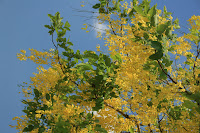
The Chet Khot-Pong Kon Sao Nature Study Centre is a park in the east of Saraburi Province, not far from the Khao Yai national park. Though usually referred to as a "Forest Park", it is not under the supervision of the National Park Division like the other forest parks. The park was created in 2000 by the agriculture minister
Pongpol Adireksarn.

The park is easy to reach, just follow the sign from Highway 2 (westwards) and turn to the left, and after about 20 km you reach a small reservoir. Turn to the left, and then the entrance is to the left shortly - directly before you arrive the boy scout camp. After the checkpoint it's another few kilometers steep uphill until you reach the visitor center. Next to the visitors center are several beautiful huts for rent, including fridge and oven - but bring a towel with you, at least when we stayed there it did not have any provided.

We only stayed there for one night, so there was not much time to hike into the forests, and to make it worse we came in the height of the dry season, so the waterfall was reduced to not much more than the water in a standard shower. And when I reached one of the waterfalls it was already near sunset, and the light was too low to do any good photos. Only in the scaled down version one does not notice it being very blurred due to the longer exposure. A second trail I took in the morning did not lead me far, but an interesting sight were the remains of a house already overgrown by the jungle again. Only the concrete foundations were still visible.

I want to come to this park again for sure, then staying at least one day to have the chance to see not just one, but all the tiers that brook forms in the valley, and also see and photograph them in their full beauty.

At least the garden and camp ground at the reservoir next to the huts gave me opportunity to take some scenic photographs, but I prefer to scenery created by nature itself.
Another report on the park I found at
thailandtraveltours.com.
 Vin de Ray (แวงเดอร์เรย์) is a small but high quality winery in Saraburi. If I remember right, it belongs to a Thai TV personality, but the wine is available for sale there in a small shop as well, so it is not solely for the personal fun of this personality. We bought a few bottles, and unlike a Thai wine I once bought in a supermarket and which tastes quite strange, the red wine we bought was same quality as the European ones. At least for the taste of a casual wine drinker. The only other thing we did there was photo taking, while I took only the vineyard with a few workers in behind, whereas my family did many photos posing in front of vine and grapes. Also, for me the large yellow shower tree gave a great color contrast with the blue sky.
Vin de Ray (แวงเดอร์เรย์) is a small but high quality winery in Saraburi. If I remember right, it belongs to a Thai TV personality, but the wine is available for sale there in a small shop as well, so it is not solely for the personal fun of this personality. We bought a few bottles, and unlike a Thai wine I once bought in a supermarket and which tastes quite strange, the red wine we bought was same quality as the European ones. At least for the taste of a casual wine drinker. The only other thing we did there was photo taking, while I took only the vineyard with a few workers in behind, whereas my family did many photos posing in front of vine and grapes. Also, for me the large yellow shower tree gave a great color contrast with the blue sky. The drive to there is also interesting. When coming from Muak Lek, one first passes a stretch of road named mystery road, as its one of those roads where the law of gravity seems to be violated. The car apparently rolls uphill, but of course this is only an optical illusion - which somehow did not work for me. A little later is a much more fascinating one, the tree tunnel. The road goes through a forested valley, and the trees have grown over the road so one drives through a nature-built tunnel. Too bad we did not stop for a photograph there.
The drive to there is also interesting. When coming from Muak Lek, one first passes a stretch of road named mystery road, as its one of those roads where the law of gravity seems to be violated. The car apparently rolls uphill, but of course this is only an optical illusion - which somehow did not work for me. A little later is a much more fascinating one, the tree tunnel. The road goes through a forested valley, and the trees have grown over the road so one drives through a nature-built tunnel. Too bad we did not stop for a photograph there.







